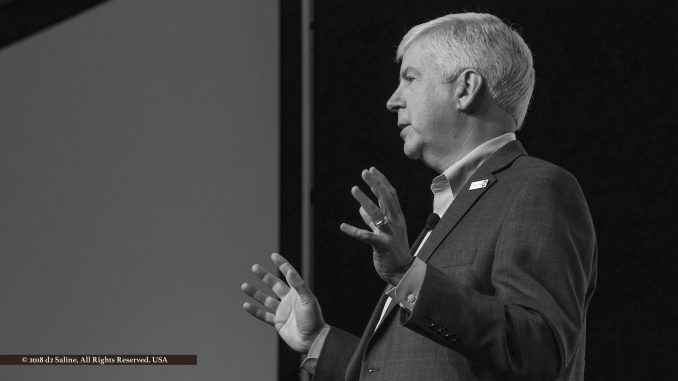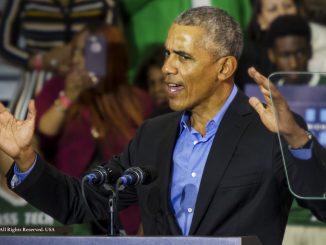
For anyone who attended The Intelligent Transportation Society of America (ITS) conference and exposition at Cobo Center this month, recent coverage of Ford Motor Company plans to transform Michigan Central Station into a mobility development hub must have seemed ironic. [1,2,3]
The train has already left the station. [4]
That’s not to say that Ford isn’t on board; indeed, it very much is. But resist the temptation to ask where it places against like kind producers from General Motors to Tesla. “Competition” didn’t seem a very popular word around ITS. Rather, the emphasis was on collaboration — and all players seemed to be embracing it. Moreover, the variety among those interest already involved is breathtaking. [5]
When our own Governor Snyder took center stage at this conference on June 6, he spoke with the power of anything but a lame duck politician. He wielded references to the Michigan Economic Development Corporation “PlanetM” initiative as if simply saying the name proved that we already own mobility. Then the governor of Colorado came out and agreed with him. [6]
Substantively, the “overwhelming success of Mcity,” Governor Snyder said, begat the “ten-times larger” American Center for Mobility (ACM). The liabilities for almost any other use of the old Willow Run Bomber assembly plant would become peerless advantages for ACM. [7,8,9]
Even more incredible to see as a total picture in Cobo Center was the degree to which autonomous vehicle and smart city commitment have already deeply permeated so many other businesses they may touch. [10]
For example, auto insurance.
In a separate, dedicated panel discussion, Wisconsin Insurance Commissioner Ted Nickel was already thinking about the future of “liability, in the very rare instance of accidents” on roads where all vehicles will be self-driven. He’s looking at a possible shift of burden to product, perhaps coupled with changes to healthcare policies that would mean more comprehensive coverage for injuries. Part and parcel of this would come entirely different kinds of litigation.
Amy Mass of The Hannover Insurance Group added that carriers “are actually quite supportive of these new technical innovations.” Their current concern is in anticipation of what they’ve labeled “the scary period” — the time between now and the inevitable, when traditional and autonomous vehicles must share the roads. She also pointed out that even the most sophisticated artificial intelligence must be programmed by someone to make decisions.
“When faced with two bad crash scenarios, how does the car decide who to hit?”
Elsewhere at the conference, Dr Michelle Mueller of Washtenaw Community College (WCC) revisited many of the points explored during their April 2018 Smart Cities symposium. Skilled trades training programs are changing, and this has required community colleges to develop even closer relationships with employers such as the Michigan Department of Transportation (MDOT). [11,12,13,14]
“We can no longer keep providing the training you needed in the past,” WCC President Dr Rose Bellanca said to Collin Castle of MDOT. “We need to prepare our students for the skills you’ll need them to have next year and then after that. We have to anticipate what you’re going to tell us.”
Adding that even he did not use core skills from his own time in college now on the job, Mr Castle noted that it’s often easier to teach new hires with a solid foundation in software “road work,” than it is the reverse. “It’s completely different out there even today.”
This sea change was palpable on the trade show floor as well. Major supplier displays were dedicated to showing how their products for use on roadways were reliably ready to communicate with autonomous vehicles. Boldly, some did not even seem to have made a passing effort to provide redundant human interface systems.
By any definition, they’re all in.
Impressively, Governor Rick Snyder layed out the Michigan autonomous story from big picture to fine detail over the course of about twenty minutes without notes or reference material of any kind. In the end, he said, there are only two concerns with going forward. The first, not surprisingly, was cyber security. The second is the need to recognize the effect this will have in displacing workers. Period.
In the weeks that have passed since The Intelligent Transportation Society of America event, Saline Journal has been approached when out and about by a number of local readers who challenged the assertion of Wall Street Journal auto columnist Dan Neil who predicted that autonomous vehicles will be on par with human drivers by the year 2026. Not one of them agreed. [15]
It’s good that they’re still reading. Because a rapidly increasing and varied number of businesses not only believe that this train has already left the station, but that it’s well on down the tracks — and picking up steam.
References
- The Intelligent Transportation Society of America (home page).
- The Intelligent Transportation Society of America 2018 Annual Meeting (home page).
- “Inside Detroit’s Crumbling Train Station That Ford Plans To Transform Into A Mobility Hub” Tamara Warren (June 20, 2018) The Verge.
- “It’s Important to Understand What Being a ‘Smart City’ Means to Saline, Part 4” Dell Deaton (April 27, 2018) Saline Journal.
- “What Cities Need to Know about Consumer Acceptance of Autonomous Vehicles” Dell Deaton (March 30, 2018) Saline Journal.
- PlanetM (home page).
- Mcity (home page).
- American Center for Mobility (home page).
- “Behind The Scenes At The American Center For Mobility In Ypsilanti Township” Jorge Avellan (April 16, 2018) WEMU.
- “Ready or Not, Autonomous Vehicles Rolled Further Ahead This Week Toward Inevitability with Mobility for All” Dell Deaton (May 31, 2018) Saline Journal.
- “It’s Important to Understand What Being a “Smart City” Means to Saline, Part 2” Dell Deaton (April 16, 2018) Saline Journal.
- “It’s Important to Understand What Being a “Smart City” Means to Saline, Part 3” Dell Deaton (April 20, 2018) Saline Journal.
- “Smart Cities: A Connected Way Forward” (April 6, 2018) Washtenaw Community College.
- MDOT: Michigan Department of Transportation (home page).
- “Trust is the Biggest Obstacle to a Mobility Revolution; Established Players Are Directly Asking You for It, Now” Dell Deaton (June 7, 2018) Saline Journal.
Hashtag
#itsdetroit2018



